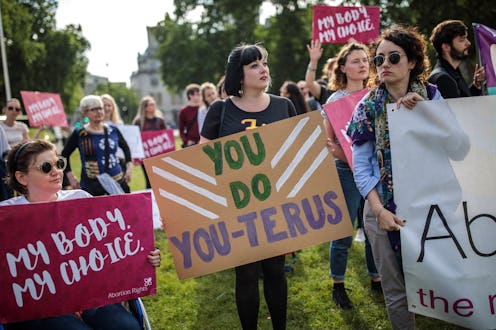Life
Abortion Clinics Are Closing At An Alarming Rate

Reproductive rights are one of the most consistent hot button issues in politics; saying they're under attack is akin to pointing out the sky is blue and Donald Trump is orange. According to Bloomberg Business, however, things may be taking a turn for the worse: Abortion clinics are closing at a record rate in the United States — the fastest since the procedure was legalized in 1973.
Bloomberg Business reports that since 2011, at least 162 abortion providers in 35 states closed their doors, while only 21 opened. An average of 31 clinics per year stopped performing abortions or shut down entirely, more than of a quarter of which occurred as the result of legislation that made it financially or logistically unfeasible to remain open. Texas is one of the frontrunners in such legislation; with the loss of at least 30 abortion clinics in the past five years, the state has the dubious honor of seeing the highest number of clinics closing their doors.
Much of this is due to to 2013 regulations requiring clinics to meet ambulatory surgical center standards and doctors to have admitting privileges at a hospital within 30 miles. Such requirements dramatically reduced the number of clinics — and by extension, the number of abortions performed — in the state, forcing some women to drive hundreds of miles for the procedure.
Although Texas is the current template for restricting abortion access, one state is not singlehandedly responsible for the drop in clinics nationwide. Even Democratic states like California, which generally lean in women's favor, have seen a substantial reduction in clinics. And neither are Texas women the only ones who may have to drive hundreds of miles to receive an abortion: The report found that 30.5 million women of reproductive age live within 25 miles of the now-closed clinics, and six states, including Mississippi and Wyoming, are down to just one clinic operating in the entire state.
Combined with mandatory waiting periods, which may require women to take off more time from work on top of travel costs and accommodations, it's clear which population is disproportionately affected: Low-income women. With some waiting periods reaching up to 72 hours between consultation and procedure, an outpatient procedure can end up spanning days, and when the nearest clinic is hundreds of miles away, this can prove logistically and financially difficult or even impossible.
As a result, many women are forced to delay the procedure while they get the money together; according to the Guttmacher Institute, seven in 10 women would have preferred to have their abortion earlier, many of whom were forced to put it off due to financial difficulties. However, the longer a woman waits, the harder (and more expensive) it becomes to receive an abortion, as state regulations on second-trimester abortions are even more restrictive.
Unfortunately, unintended pregnancies are the most common in low-income women as the result of a variety of factors, and so we're left with a conundrum: Low-income women are more likely to have an unplanned pregnancy, but they face the most obstacles when it comes to terminating it. When a low-income woman is forced to carry a baby to term, however, she's blamed for getting pregnant in the first place. The obvious solution is to improve access to birth control for all women — but if the current state of reproductive rights is anything to go by, that's looking less likely every day.
Images: Jack Taylor/Getty Images, FRANCOIS GUILLOT/AFP/Getty Images